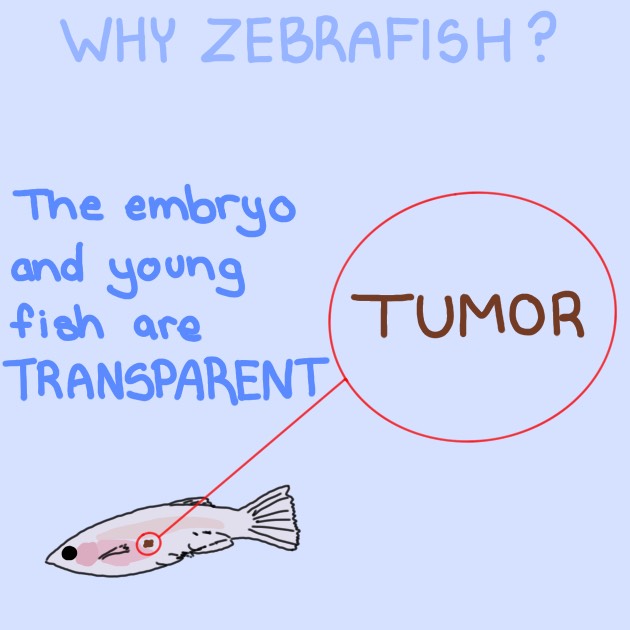The general public may think animal research is all about lab rats receiving drug cocktails in some hidden away laboratory. In reality, the field of animal research is rapidly changing, not with lab rats but with invaluable, minuscule fish. Meet the zebrafish. Shorter than your finger, a zebrafish is completely transparent at birth and doesn’t develop an adaptive immune system until 2 weeks after hatching. These peculiar traits make it a truly unique specimen in the field of biomedical research.
When studying cancer, one of the biggest hurdles is that it’s very difficult to tell exactly where the cancer has spread without conducting surgery. Furthermore, creating metastasis (a secondary spread of cancer away from its origin) in a lab setting can be both difficult and costly because the subject’s growth can take varying amounts of time. Not just that, but cancer research with traditional animals, such as mice, have sometimes proven to be inefficient. How can we address these issues to spur novel treatments for animals and humans? Some scientists say zebrafish are the answer.
When zebrafish are in the larval stage, they can be inserted with human cancer which will eventually metastasize. In one study by Dr. Yong Teng of Emory University, he and his research team introduced cancer cells into the zebrafish and then monitored, with results showing metastasis within 24 hours. Keep in mind zebrafish are transparent and their immune systems are non-adaptive, so the cancer can easily be pinpointed and tracked through noninvasive imaging. This rapid turnaround is unprecedented and is just the tip of the iceberg when it comes to the zebrafish’s role in cancer research.
In the past, cancer metastasis has been difficult to effectively and efficiently treat since the location of cancer metastasis was previously seen as random. However, research with zebrafish has yielded some very promising results indicating the contrary. In Dr. Teng’s study, he found because of the zebrafish’s ability to harbor human cancer cells, zebrafish are a “tractable model to assay metastatic potential of human cancer cells.” In other words, we can determine how likely the primary tumor can initiate metastatic growth. Just by looking at the primary tumor, scientists can understand if and where the cancer has spread.
Dr. Teng’s research in zebrafish can also be applied to human cancers. Researchers examined traditionally non-metastatic forms of breast cancer by injecting them into zebrafish. As the researchers hypothesized, none of the cancers that metastasize in humans do so in zebrafish. Several metastatic cancers, however, including forms of breast, colon, pancreatic and prostate cancers, did metastasize in zebrafish. As Dr. Teng stated, “around 70% of human disease genes have functional homologs in zebrafish.” To put it another way, zebrafish and human tumors are similar genetically.
“In the process of gathering evidence around my idea of creating zebrafish models, I was surprised the tumor development and progression in zebrafish is histologically and genetically similar to that of humans,” said Dr. Teng. Based on the cancer’s histology (studies of the tissue makeup of the tumor), genetically similar cancers exhibit similar metastasis patterns that mutations cause.
It is extraordinarily rare to find an animal with reactions to cancer so similar to humans. Many mollusks, for example, have highly contagious cancers they pass through their colonies. Elephants, on the other hand, are highly resistant to cancer. While the scourge of cancer exists throughout the animal kingdom, the zebrafish play a key role. As Dr. Teng puts it, “Zebrafish cancer models offer a rapid, robust, and inexpensive means of evaluating the metastatic potential of human cancer cells. These models provide a time-cost-effective platform for screening and identifying anti-metastasis drugs and compounds.”
As the ever-transforming field of cancer research progresses, more tests need to be conducted to investigate patterns of metastasis. Although it accounts for more than 90% of cancer deaths, cancer metastasis has been nearly impossible to quantify and predict. As zebrafish prove to be an ideal model organism for cancer treatments, the next breakthrough cancer drug may be swimming in a laboratory near you.
- Some scientists believe tiny fish called zebrafish have the potential to play a critical role in combatting cancer.
- One of the many benefits of studying zebrafish is their transparency, allowing cancer to be easily pinpointed and tracked through noninvasive imaging.
- Zebrafish are also helpful for studying the secondary spread of cancer away from its origin, called metastasis.
Sources
Dr. Yong Teng. Interview with Dr. Yong Teng Conducted by Rajveer Singh. Published online August 10, 2021.
Kandice Tanner et. al. Tumor Cells in Transparent Fish reveal Physical and Molecular Factors that Determine Metastasis Sites. CCR. Published online August 21, 2019. https://ccr.cancer.gov/news/article/tumor-cells-in-transparent-fish-reveal-physical-and-molecular-factors-that-determine-metastasis-sites
Nakayama J, Makinoshima H. Zebrafish-based screening models for the
identification of anti-metastatic drugs. Molecules. 2020;25(10):2407. doi:10.3390/molecules25102407
Osmani N, Goetz JG. Multiscale Imaging of Metastasis in Zebrafish. Trends in Cancer. 2019;5(12):766-778. doi:10.1016/j.trecan.2019.10.003
6.Teng Y, Xie X, Walker S, White DT, Mumm JS, Cowell JK. Evaluating human cancer cell metastasis in zebrafish. BMC Cancer. 2013;13:453. doi:10.1186/1471-2407-13-453
Why use the zebrafish in research? yourgenome. Accessed September 8, 2021. https://www.yourgenome.org/facts/why-use-the-zebrafish-in-research
Zebrafish. Come See Our World. Accessed September 8, 2021. https://www.comeseeourworld.org/animals/zebrafish/
Editorial Team
Chief Editor: Karishma Goswami
Team Editor: Kevin Liu
Creative Team Managers: Daniela Benoit, Bebe
Lemanowicz
Social Media Team Manager: Spencer Lyudovyk
Image Credits: Daniela Benoit
Mentor
Lisa Newbern is Chief, Public Affairs, for Yerkes National Primate Research Center (NPRC) at Emory University. In this role, she provides strategic counsel, develops measurable action plans and leads teams in executing communication programs that include executive messaging, issues and risk management, media relations, internal communication, community, educational and collaborative outreach, social media, online presence, government relations, special events, sponsorship opportunities, fundraising and historical archiving. She also leads the collaborative public relations initiatives for the seven NPRCs, including NPRC.org and @NPRCnews. Among her service activities, she is a board member for Americans for Medical Progress; a member of the Georgia Department of Education Division of Special Education State Advisory Panel and a mentor to students in Emory University’s Genetics Counseling Program.
Content Expert
Dr. Yong Teng, Ph.D. is a oncology researcher at the Winship Cancer Institute at Emory University. His expertise is in cancer metastasis and metabolism, and he has conducted several pioneer studies using zebrafish as a model organism.



